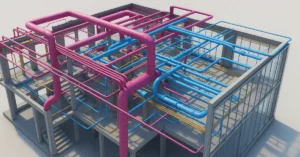The Role of BIM in Saudi Arabia’s Vision 2030 Projects
Saudi Arabia’s Vision 2030 is an ambitious plan aimed at transforming the country’s economy, reducing its dependence on oil, and developing public service sectors such as health, education, infrastructure, recreation, and tourism. Central to this vision is the adoption of advanced technologies and innovative methodologies to ensure efficient project delivery, sustainability, and economic diversification. Building Information Modeling (BIM) is one such technology that plays a critical role in the realization of Vision 2030. BIM is revolutionizing the construction and infrastructure landscape in Saudi Arabia, providing a comprehensive approach to project management, design, and execution.
Understanding BIM and Its Importance
BIM is a digital representation of the physical and functional characteristics of a facility. It serves as a shared knowledge resource for information about a facility, forming a reliable basis for decisions during its lifecycle, from inception to demolition. BIM integrates multi-disciplinary data to create detailed digital representations that are managed in an open cloud platform for real-time collaboration.
The importance of BIM in construction and infrastructure projects cannot be overstated. It enhances collaboration, reduces errors and rework, improves project efficiency, and leads to better project outcomes. For Saudi Arabia, where large-scale infrastructure projects are the cornerstone of Vision 2030, BIM’s role is pivotal.
Vision 2030: An Overview
Launched in April 2016, Vision 2030 aims to diversify Saudi Arabia’s economy and develop public service sectors. Key goals include:
- Economic Diversification: Reducing dependence on oil and increasing non-oil revenue.
- Infrastructure Development: Developing smart cities, transportation networks, and public facilities.
- Sustainability: Ensuring environmental sustainability through green building practices and renewable energy projects.
- Tourism and Recreation: Developing tourism infrastructure to attract international visitors.
- Public Services: Enhancing healthcare, education, and social services.
The Role of BIM in Vision 2030 Projects
Enhancing Project Efficiency and Collaboration
BIM facilitates enhanced project efficiency by fostering better collaboration among all stakeholders. In traditional project management, disparate data silos often lead to miscommunication and errors. BIM provides a unified platform where architects, engineers, contractors, and owners can collaborate seamlessly, ensuring that everyone has access to the same updated information. This reduces the risk of errors and rework, leading to faster project delivery.
In Saudi Arabia, where megaprojects like NEOM, the Red Sea Project, and Qiddiya are underway, efficient collaboration is crucial. BIM enables integrated project delivery (IPD), where all stakeholders work together from the project’s inception, leading to more innovative solutions and efficient use of resources.
Supporting Sustainable Development
Sustainability is a key component of Vision 2030, and BIM plays a significant role in achieving this goal. BIM enables detailed analysis of a building’s performance, including energy consumption, water usage, and environmental impact. By simulating various scenarios, BIM allows designers to make informed decisions that enhance sustainability.
For example, BIM can be used to optimize the design of a building to maximize natural light and ventilation, reducing the need for artificial lighting and HVAC systems. This not only reduces energy consumption but also improves the comfort and well-being of occupants. In the context of Vision 2030, BIM’s ability to support sustainable design is critical for the development of green buildings and smart cities.
Improving Construction Quality and Safety
Construction quality and safety are paramount in the realization of Vision 2030 projects. BIM enhances construction quality by providing detailed and accurate designs, which reduce the likelihood of errors during construction. Additionally, BIM’s ability to visualize complex structures in 3D allows for better planning and execution.
Safety is another area where BIM excels. Through 4D simulations, which integrate time with 3D models, project managers can plan construction sequences to minimize hazards. This is particularly important in Saudi Arabia, where large-scale construction projects often involve significant risks. BIM allows for the identification and mitigation of potential safety issues before they arise on-site.
Cost Management and Resource Optimization
Cost management is a critical aspect of any construction project. BIM contributes to better cost management by providing accurate quantity take-offs and cost estimates. This reduces the risk of cost overruns, which are common in large-scale projects. BIM also supports lifecycle cost analysis, allowing for more informed decisions about the long-term costs and benefits of various design options.
Resource optimization is another key benefit of BIM. By integrating data on materials, labor, and equipment, BIM enables more efficient use of resources. This is particularly important in Saudi Arabia, where large-scale projects require substantial investments. Efficient resource management ensures that these investments deliver maximum value.
Case Studies: BIM in Action
NEOM
NEOM is one of the most ambitious projects under Vision 2030. It is a planned cross-border city in the Tabuk Province of northwestern Saudi Arabia. The project aims to incorporate smart city technologies and function as a tourist destination. NEOM will cover an area of 26,500 square kilometers and is expected to have significant economic implications for the region.
BIM is integral to NEOM’s development, facilitating efficient planning, design, and construction. The project utilizes BIM for digital twin technology, creating a virtual replica of the city that allows for real-time monitoring and management. This ensures that the city’s development is aligned with sustainability and efficiency goals.
The Red Sea Project
The Red Sea Project is a luxury tourism development on the west coast of Saudi Arabia. It aims to position the country as a leading global tourism destination. The project includes the development of resorts, residential properties, and recreational facilities across 50 islands and 22,000 square kilometers of desert and mountains.
BIM plays a crucial role in the Red Sea Project by enhancing design and construction processes. The project uses BIM to ensure that all developments are in harmony with the natural environment, minimizing the ecological footprint. BIM also supports efficient project management, ensuring timely and cost-effective delivery.
Qiddiya
Qiddiya is an entertainment megaproject located near Riyadh. It aims to become the capital of entertainment, sports, and the arts in Saudi Arabia. The project includes theme parks, sports facilities, and cultural attractions, and is expected to attract millions of visitors annually.
BIM is used extensively in Qiddiya to manage the complex design and construction processes. By integrating various design disciplines into a single model, BIM ensures that all elements of the project are coordinated. This reduces the risk of conflicts and delays, ensuring that the project stays on schedule and within budget.
Challenges and Opportunities
Challenges
While BIM offers numerous benefits, its adoption in Saudi Arabia faces several challenges:
- Lack of Skilled Professionals: There is a shortage of professionals with expertise in BIM, which can hinder its widespread adoption.
- High Initial Costs: Implementing BIM requires significant initial investment in software, hardware, and training.
- Resistance to Change: The construction industry in Saudi Arabia, like in many other countries, is traditionally conservative and may resist changes in established processes.
Opportunities
Despite these challenges, the opportunities presented by BIM are substantial:
- Training and Education: Establishing training programs and academic courses in BIM can address the skills gap and prepare the workforce for future projects.
- Government Support: The Saudi government’s support for Vision 2030 and its emphasis on technology and innovation can drive the adoption of BIM.
- Global Collaboration: Collaborating with international experts and companies can bring in the necessary expertise and experience to implement BIM effectively.
Conclusion
Building Information Modeling (BIM) is a transformative technology that plays a crucial role in the realization of Saudi Arabia’s Vision 2030. By enhancing project efficiency, supporting sustainable development, improving construction quality and safety, and optimizing costs and resources, BIM contributes significantly to the success of large-scale infrastructure projects. Despite challenges, the opportunities for BIM adoption are immense, and with the right strategies, Saudi Arabia can leverage BIM to achieve its ambitious Vision 2030 goals. As the country continues to invest in technology and innovation, BIM will undoubtedly be a cornerstone of its future development.
If you’re interested in learning more about architecture firms in Europe, check out this comprehensive list of the top 50 firms compiled by Archgyan. From innovative startups to long-established industry leaders, this list has it all. Take a look and discover some of the most inspiring and influential architecture firms in Europe today.
If you’re interested in architecture and want to learn more about this amazing field, subscribe to our podcast on youtube
For more SketchUp tutorials, head to https://www.sketchupguru.com










